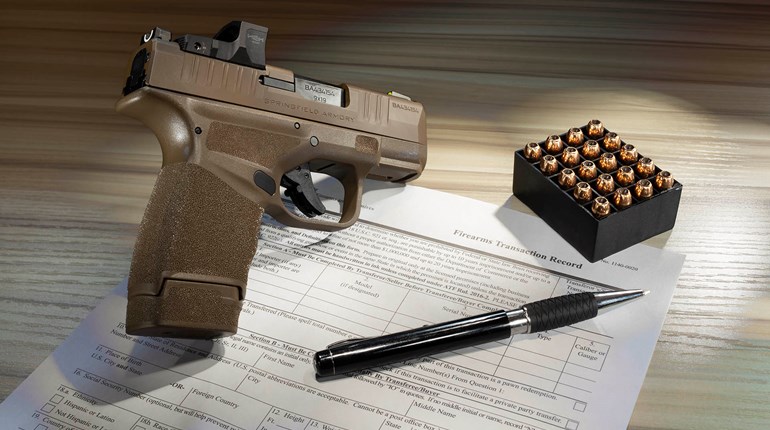
Despite all the work the NRA does to promote safe and responsible gun ownership, you’ll often see dramatic headlines accusing the NRA of being against safety—especially when the NRA-ILA files lawsuits against one-size-fits-all gun-storage laws.
“What gun safety? NRA using lawsuits to shoot down local gun-storage laws,” screeched one Salon headline.
“If the NRA [wants] to be on record fighting responsible gun ownership, that’s their choice,” said Seattle’s city attorney, Pete Holmes, after the NRA filed a lawsuit against that city for trying to pre-empt the state’s gun laws with its own mandatory-storage laws.
This kind of spin of the NRA’s positions regarding mandatory firearms storage laws is rampant. Gun-control organizations like Everytown for Gun Safety advocate that gun owners keep their guns “locked, unloaded and separate from ammunition.” And, indeed, even the NRA agrees on that method of storage when it comes to guns not currently in use. So, someone who doesn’t follow this issue might ask: Why does the NRA file legal challenges to so-called “safe-storage” laws?
The reason begins with the fact that these laws are often unconstitutional infringements on the Second Amendment of the U.S. Bill of Rights; after all, if you must keep all your guns unloaded and locked away, then you will have no ability to use one to defend yourself if a criminal comes for you. Defensive gun uses—by even the most-conservative estimates—are four to five times more common than crimes involving guns. Guns are most often owned for self-defense rather than sporting purposes, and a self-defense gun is always in use.
You should still lock up a self-defense gun when it’s not under your control, of course, but storing it in the multi-level manner Everytown and their ilk would like to mandate could render you and your family completely unsafe should you need to protect yourself and your loved ones against a violent assailant.
Indeed, while burglary and other home-invasion rates may have been going down over the last decade (from 1.9 million reported in 2011 to 600,000 in 2021 per the FBI Crime Data Explorer), and only a small percentage of those turn violent (ranging from 5-8%, depending on the year), numbers surely won’t be much comfort when you’re in that small percentage. Violent predators already inside your home know they aren’t likely to be caught in the act, so these situations can turn horrific—just do a search for “home invasions” and see what can and does happen.
And, since the safety of children is supposedly of paramount interest in mandating storage laws, it’s important to note that, according to the Department of Justice’s (DOJ) 2010 report, the National Crime Victimization Survey, households composed of single females with children had the highest rates of burglaries occurring while someone was present. Unsurprisingly, violent criminals choose to victimize those they think are the easiest targets.
While it’s difficult to find reliable statistics on how long it might take for someone to force their way into a home, a criminal could certainly get into most homes before anyone can respond. If you had managed to successfully access multiple storage locations to get your gun and then your ammo after calling for help, you’d still need to load the gun while your adrenaline is pumping and your hands are shaking and your family is in danger.
Nevertheless, Everytown’s website claims: “There are many affordable options for firearm storage that provide owners with quick access to their guns while still preventing access by children and people at increased risk of harming themselves or others.” That’s not inaccurate, exactly, and we’ll go over such options: but it is incomplete, as true “quick access” for defensive purposes can’t be achieved with their criteria. That’s the preeminent reason why top-down safe-storage laws are not the good idea they might seem to be to someone who knows nothing about home defense—they can render people completely unsafe.
Mandatory storage laws are also unnecessary, as existing laws already bar negligent and dangerous behavior. As NRA-ILA pointed out in a blog post responding to reporters from The Washington Post complaining about a lack of explicit “safe-storage” laws in Virginia:
There is no section of the Code of Virginia titled, “Prohibition on providing young children with gasoline and matches to play with.” Does that mean it’s legal in the Old Dominion to give young children gasoline and matches to amuse themselves? Of course not. … Whether it’s a child endangerment statute, a criminal negligence statute, or a reckless handling of firearms statute, states already prohibit actual reckless behavior with firearms around children. The statutes may look different and may not reference firearms explicitly, but the prohibition on reckless conduct involving firearms is clear.
Those who propose mandatory gun-storage laws often add scary statistics to their argument, many of which, again, are not inaccurate so much as they are incomplete or otherwise misleading; one such favored talking point among the anti-Second Amendment crowd these days is that “Guns are the leading killer of children in America, and the numbers are rising,” as President Joe Biden (D) tweeted in April. But, as an analysis from the Crime Prevention Research Center (CPRC) shows, the numbers on which that claim is based include many dubious data points. Most Americans, for example, would not consider justified homicides—i.e., self-defense—problematic, but these are included in the data under the general heading of homicides. Most also understand that, while the rates of suicide by firearm might go down if guns were not a factor, suicide rates overall likely would not. Finally, most Americans hearing this talking point would not envision the term “children” to include 15-to-19-year-old gang members killing each other in drug-turf wars. The homicides of those aged 18 and 19 years old make up about one-third of the firearm-related deaths included in this misleading data, while those in the 15 to 17 range make up about 20% of firearm-realted deaths.
But burdening law-abiding gun owners with more and more legal requirements has never been about safety; it’s about discouraging the exercise of your natural rights. One can easily see why citizens who live in locations requiring an Everytown-storage method wouldn’t bother to arm themselves at all, since the chances of defending themselves with a tool they probably couldn’t access in time are very low. (Those chances go down even more when you consider the innumerable other burdensome laws such districts typically impose.)
Enforcement is yet another problem with mandated, top-down, one-size-fits-all “safe-storage” laws. “‘Safe-storage laws’ are fundamentally unconstitutional,” Mark Oliva of the National Shooting Sports Foundation (NSSF) told America’s 1st Freedom, “and they’re unenforceable without law enforcement coming into your home to check.” Of course, police conducting random checks of your home is not exactly commensurate with a free society—in addition to being deeply problematic under the Fourth Amendment.
Yet another concern with mandated storage is that, just as with gun bans, these laws can embolden criminals. According to Dr. John Lott of the CPRC, “Such [mandated storage] laws emboldened criminals to attack more people in their homes; there were 300 more total murders and 4,000 more rapes occurring each year in the states with these laws. Burglaries also rose dramatically. … That is not particularly surprising given that crime rises when we impede people from protecting themselves. Indeed, every place in the world that has banned guns has seen an increase in murder.”
Keeping guns out of the reach of children and other unauthorized individuals is important, and NRA has been the national leader on this front for more than 150 years. Today, the NRA offers free gun-safety information online and NRA instructors are required to devote a significant portion of class time to ensuring that new gun owners understand and consider what storage methods are best for their situation.
The firearms industry also greatly contributes to the effort to encourage responsible gun ownership generally and safe-storage practices specifically. The NSSF provides a free pamphlet on its website that lays out various factors to consider regarding the safe handling and storage of firearms. Additionally, the industry overall has pushed free gun-safety information and cable locks out to communities and new gun purchasers—efforts that preceded any mandates.
So, what does realistic gun-storage safety actually look like? Beyond keeping all firearms inaccessible to unauthorized people, this is impossible to define in an absolute way, as every gun owner must assess their own needs and risks. A home with young children and where the only gun is used to hunt for a month each year has an entirely different safety situation than the home of an elderly widow with no children who is living on a limited income in a crime-riddled area. A family with a troubled individual would certainly require the most-secure storage options available or may even need to remove their firearms from the home. (Some organizations, like Hold My Guns, partner with gun stores and other FFLs to keep guns in trust for such situations.) The landscape of true safety changes day to day, or even moment to moment, especially in volatile times like we saw during the pandemic, and it should not be dictated in a one-size-fits-all regulation. Gun owners themselves must decide how to limit access to their firearms.


































